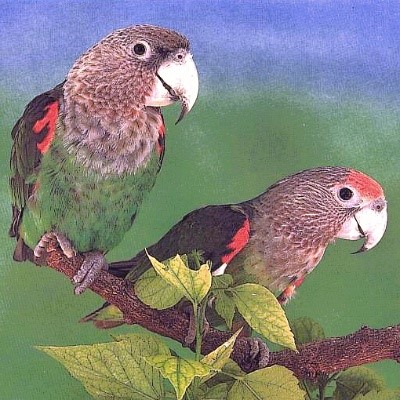Resource 4: Cape parrot
![]() Example of pupils' work
Example of pupils' work

Cape parrot (Poicephalus robustus) or Grootpapegaai
- Height: 30 cm
- Beak length: 31–37 mm
- Habitat: Afromontane Yellowwood Forest
- Status: Critically endangered
The Cape parrot is a medium-sized parrot originating from South-eastern Africa. They are known as ‘Gentle Giants’ with an intelligence level similar to or even exceeding that of an African grey.
Since the various species that are part of the Poicephalus family of parrots are all so similar, and have recently undergone a reclassification process, special care has to be taken when identifying the Cape parrot.
The Cape parrot can be identified by its greenish to yellowish brown neck and head. The hen has a pinkish-red/orange crown and forehead but true sexing can only be done through DNA testing because some of the young males also display these markings before they mature. Both the male and female Cape parrot moult in more orange on the upper wings and shoulders.
The Cape parrot’s preferred habitat is the misty mountainous forests of the Eastern Cape and KwaZulu-Natal, western Zululand, Swaziland and Mpumalanga. They choose nesting sites higher than 1,000 metres above sea level and prefer to nest high up in the hollows of upright dead yellowwood trees.
The Cape parrot breeding season is between August and February, and the hen will lay two to five eggs. After about 29 days the eggs will hatch and the parents will take care of the hatchlings until they leave the nests – generally about 60 to 70 days later. Only after four to six years will the parrots be ready for mating and breeding.
The Cape parrot has a short but powerful beak, perfect for the hard seed kernels that they eat. Once again it is the yellowwood fruit that they prefer. With their beaks they easily remove the hard outer shell of these kernels to get at the core. However, when forest foods become scarce they often move into fruit orchards, enjoying the pips of fruits like apricots and peaches, as well as the seeds from black acacias, eucalyptus and pecans.
Did you know?
The Cape parrot’s beak is so strong that even the babies have to be ringed with special stainless steel bands, since they simply crush standard aluminium rings.
Threats to the Cape parrot
The Cape parrot is considered one of South Africa’s most endangered birds. It is estimated that there are only about 1,500 to as little as 500 left in the wild, but these numbers are dwindling fast as a result of various factors:
- Massive habitat destruction and fragmentation – Yellowwood forests were plundered during the last century. Yellowwood was, and still is, a highly sought after commodity for the furniture industry because of its beauty and durability. Furthermore, formal and informal housing is ever-encroaching on our natural forests; people and livestock disturb the natural balance, and dead yellowwoods often end up being used as firewood.
- The illegal trade of Cape parrots for aviculture and medicine – Cape parrots are beautiful, intelligent, mild tempered and have a great love for humans – the makings of a great pet. Unfortunately they are taken from the wild and sold on the black market as pets, and also for medicinal use in the ever-growing muti trade.
- Slow breeding rate – Wild Cape parrots will only start breeding after four to six years and have poor breeding success – many chicks never reach adulthood.
- Psittacine beak and feather disease – This disease is referred to as a kind of avian AIDS. Initially discovered amongst captive-bred birds, PBFD now seems to have spread to some wild populations in the Eastern Cape. This disease poses a real threat to the Cape parrot. Infected birds will almost certainly die and currently there is no vaccine or cure for PBFD. Not a lot is known about this disease and it can only be diagnosed through a complicated biochemical procedure.
What is being done?
Currently various captive breeding programmes are underway, but it has proved to be almost impossible to rehabilitate captive bred parrots back into the wild. The imprinted birds never lose their love for humans and don’t seem to adapt to living in the wild and fending for themselves. The outbreak of psittacine beak and feather disease has also slowed down these initiatives since researchers are scared to release possibly infected birds into the wild.
In 1993, the University of Natal launched a research project initiated by the late Olaf Wirminghaus. Today, the Cape Parrot Working Group is carried on by Colleen Downs and Craig Symes. They have set out a list of objectives, which includes promoting conservation of the Cape parrot and its natural habitat, raising awareness and lobbying for better laws to protect the Cape parrot and its habitat. They have also set up a captive breeding programme to boost the number of Cape parrots.
Additionally, the Cape Parrot Working Group has been erecting nesting boxes in the wild. When there is a shortage of natural nesting sites, these serve as a suitable alternative.
The Cape Parrot Working Group also hosts the annual Cape Parrot Day, which aims to make people more aware of the plight of these birds, as well as keeping an eye on the number of Cape parrots in the wild. Over 400 Cape parrots were sighted at various locations throughout the country during the Cape Parrot day in May 2002.
Adapted from: 50/50 Website
Resource 3: History of technology



